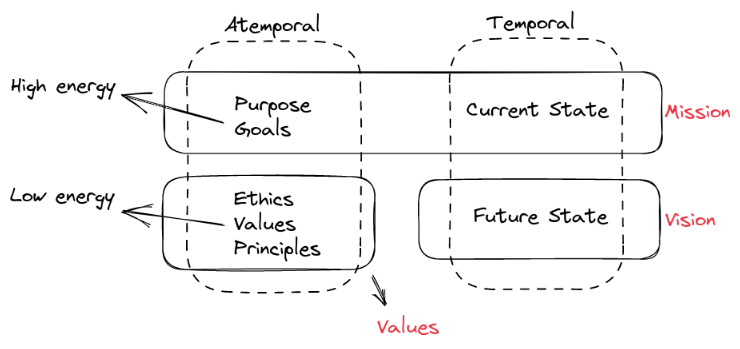As a first-time founder, one of the most reflective and challenging subjects is understanding the definition of mission, vision, and values, especially mission. Before defining these statements for your company, you need to know their meaning. Using my case as an example, a friend told me he couldn't see what my company does because these statements weren't clear, and he was right. They weren't clear even to me because I lacked a solid definition.
Thus I decided to take some time to study and learn these definitions. After a whole weekend of discussing and asking, "Why do we do this?", "What is your purpose?", "What motivate us?" I can say that I finally could comprehend those definitions better. Before sharing the characterization I found, I need to step back and understand some atemporal and temporal characteristics.
Atemporal and Temporal Characteristics
Temporal characteristics are essentially linked with time. They will necessarily change over time. They're the current state and the state your company wants to be in the future. The path between these two will lead your organization to a future state.
On the other hand, atemporal characteristics don't change with time and are intrinsic characteristics of some person or company. We can include purpose, goals, values, ethics, and principles in this list. Ok, they may change as time pass by, but this won't necessarily happen. We divide them into low and high-energy groups. The purpose and goals are high energy because they create a driver inside us and make us want to take action. Values, ethics, and principles are low energy because they're more like guides, making us more reflexive.

Atemporal and temporal characteristics diagram.
Mission, Vision, and Values
After determining those atemporal and temporal characteristics, I can define mission, vision, and values.
Values are the atemporal characteristic of low energy, like principles, ethics, and values. They define the organization's beliefs and how employees behave with themselves, customers, clients, or other stakeholders. They provide a moral direction that guides decision-making and team member action standards.
Vision is the state where your company wants to be. It's the future state of the temporal characteristics. It has a broad scope, and many organizations can use the same statement. For example, Disney's vision is "To make people happy."
Mission was the most difficult because it requires temporal and atemporal characteristics. We can see the mission as the same as the purpose and goals, the high energy of atemporal. But it also correlates to your company's current state and what it needs to do now to achieve the vision. For instance, Tesla's mission is "To accelerate the world's transition to sustainable energy." The statement can answer the questions, "What is the purpose?" and "What does the company need to do now to achieve the vision?".
It's essential to define mission, vision, and values because they are the core of your business and determine your organization's identity. Without them, people won't know what you do and the reasons to do what they're supposed to do. Also, people working there won't see why they're doing their job, leading to disengagement.
At early-stage startups, a great definition of mission, vision, and values is necessary to attract the best people to work with you. People who identify with your statements will want to work with you to help accomplish the mission to reach the vision, guided by the values. They're the most lethal weapon in your recruiting arsenal and hold enough power to make people want to work with you.